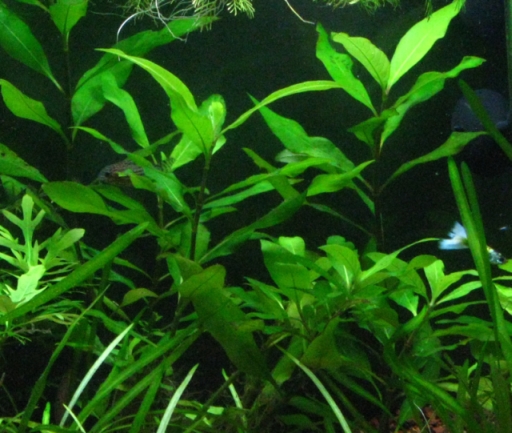March 14, 2011
May 08, 2010
Rainbow Cichlids, Busy at 4:16 a.m.
May 04, 2010
My First Try at an Old Aquascaping Idea
I did my bit of elementary aquascaping, this evening, by wrapping clumps of good old fashioned Java Moss around a branch, tying dark, heavy cotton thread to the branch, and then wrapping the thread in a spiral over the moss. A couple of such passes, one on each of two sides of the branch, sufficed for a pretty good cover. Then a few snips with scissors, where the moss came up in obvious loops between the wrappings of thread, served to obscure a good bit of the man made nature of the artifact. Fun. Easy. Pretty. Pictures to come.
January 30, 2010
Pee-wee Gets an iPad!
January 14, 2010
Me and the Scorpion
My dad, though, was pretty much guaranteed to fly into a rage if I came clean with the fact that I'd gotten stung. So, real casual-like, I initiated a conversation with the adults in the group about scorpions, and real, real casually checked out what they knew about scorpion stings. It sounded to me like it was about as bad as a bee sting, so I decided not to say anything further on the subject. I'll never forget the day, though.
Here's the guy who got me: "The only scorpion known to occur in Arkansas . . . the common striped bark scorpion."

"Death and severe allergic reactions have been attributed to the striped bark scorpions, but such claims have never been substantiated by reputable sources."
January 03, 2010
Bruce Sterling: State of the World 2010
September 03, 2009
My Planted 10 Gallon Aquarium
This was all grown using fermented-yeast-and-sugar DIY CO2, though I've since switched over to pressurized CO2 setup with a tank, regulator, pH probe and controller. My lighting is two 5500k 13 watt screw-in compact fluorescent bulbs in the original equipment somewhat funky plastic hood. I use Seachem liquid fertilizers.
The vertebrate population includes one male Platinum Guppy, who shows up as a blur about halfway from top to bottom, almost to the left margin of the tank. Also, five Neon Tetras, three Corydoras trilineatus, one Siamese Algae Eater, and two Badis badis. There were a couple of large pond snails, but I guess they died of old age. No other invertebrates that I know of.
This shot is, so far, the height of my artistry as a planted aquarium geek.
August 18, 2009
Fun with German Guppy Enthusiasts

The fish above is from his most recent blog post, titled "piebald reticulata".
The first link a the forum is this, a thread that shows pictures of Tobi's, the Guppyfocus guy's, fishroom. The last pic in the series is interesting, as Tobi has mentioned a "Channa" that he feeds culled guppies to. It's a nice little planted tank, and I think you can see the snakehead hovering in mid-tank. According to this link, this may be the fish that has been terrorizing anglers in my brother's suburban D.C. area in recent years.
Next, a thread in which a young woman guppy breeder shares a series of shots of a group of male guppies, posing the group a puzzle as to how, genetically, she reached their phenotype, genetics-talk for their appearance.
Finally, here's the forum's "portal" page, pumped through Google Translate.
Wait, there's more! They're like peanuts, I can't stop. Two amazing "Pink Moscow Males". I hope you enjoyed the tour.
May 21, 2009
May 09, 2009
Unstable CO2 Concentration as a Cause of Algae in Planted Aquariums
 I just found the text quoted below in this article.
I just found the text quoted below in this article.Unstable CO2
Both plants and algae adapt to CO2 in their environment. To do this, they produces what’s call the Rubisco. The Rubisco is an enzyme that is used for carbon fixation. In a low CO2 environment, plants and algae will produces more Rubisco so they can fix carbon from the KH (-HCO3). When there is plenty of CO2, plants and algae no longer need the Rubisco so they simply get rid of it.
Problems show up when CO2 is unstable because algae are much faster to adapt to low CO2 than plants. So everytime your CO2 is changing, algae have a chance to outcompete the plants.
When I saw the enzyme RuBisCO mentioned, I remembered the first time I heard that word, which was at a meeting of the Atlanta Area Aquarium Association, during member Brian Revennaugh's great presentation on planted aquariums. If you'd been in the room with me, you probably could have seen the light go on over my head. Aha!
I've been a student of aquarium keeping, and especially planted aquariums, my whole life, and it is wonderful to be able to keep learning things about it.
Addendum: Brian R. adds some depth and precision in his post at the AAAA Forum discussion of this topic.



